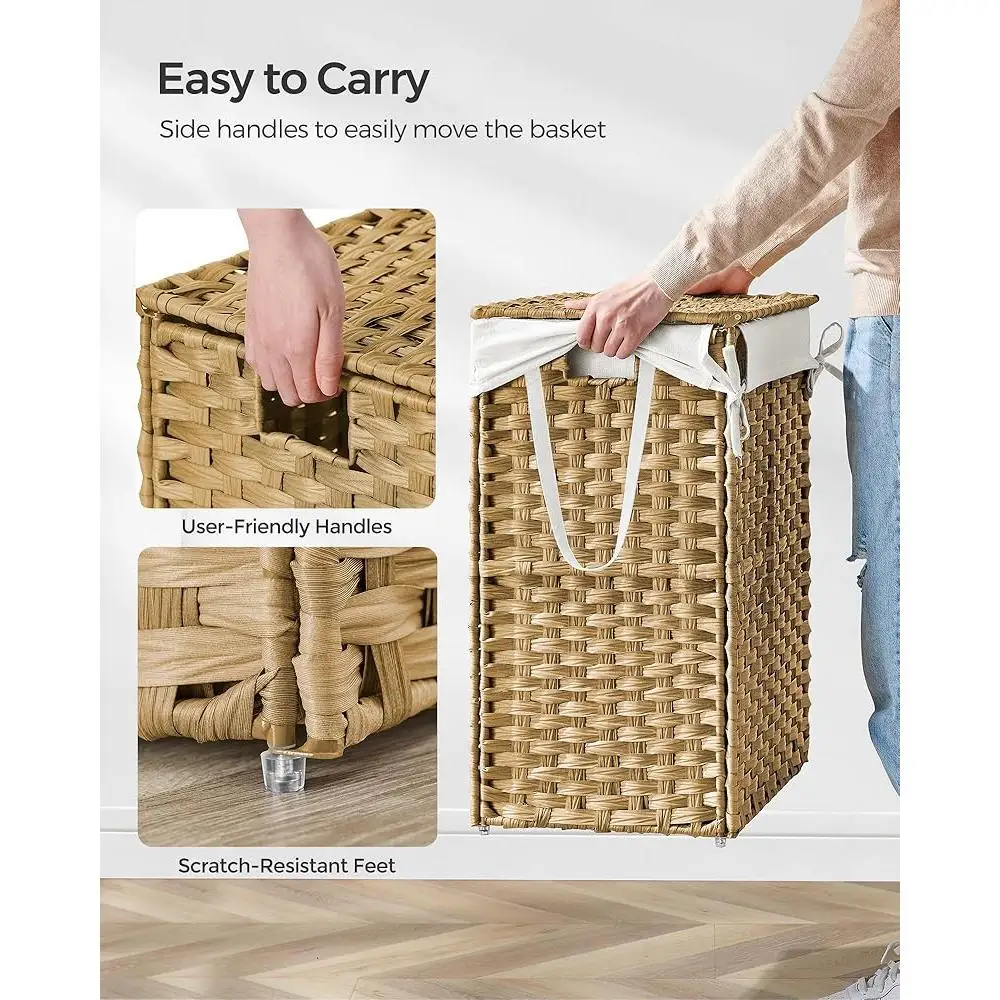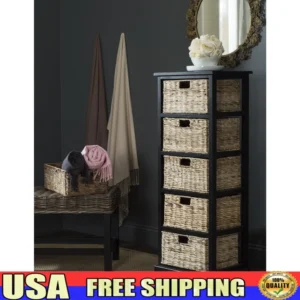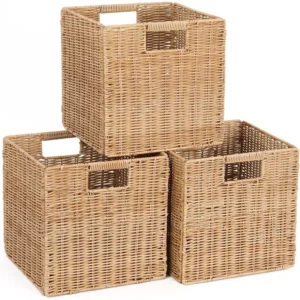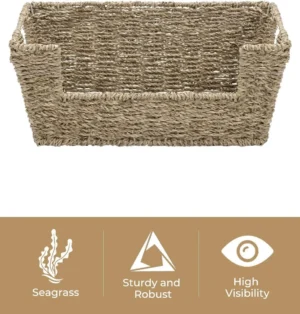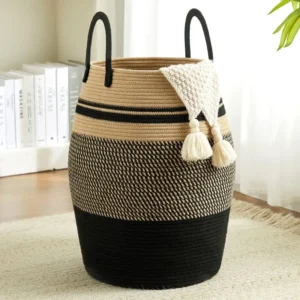What’s the Real Difference Between Wicker and Woven Baskets?
When shopping for storage solutions, you’ve likely come across both “wicker” and “woven” baskets. The terminology can be confusing, leaving many wondering: aren’t they the same thing? This common misconception deserves clarification.
Definition Box:
Wicker = A specific technique of weaving rigid materials into a sturdy structure
Woven = Any method of interlacing flexible materials to create an item
The key distinction lies in understanding that wicker refers to a particular weaving method, not a material. All wicker baskets are woven items, but not all woven baskets qualify as wicker. Think of wicker as a subset of the broader “woven” category – similar to how all squares are rectangles, but not all rectangles are squares.
Many shoppers mistakenly use these terms interchangeably, which can lead to confusion when searching for the perfect storage solution. Knowing the difference matters because it directly impacts what you’re getting in terms of durability, appearance, and functionality. The unique characteristics of wicker vs. woven baskets affect everything from how much weight they can hold to how they’ll look in your home.
Understanding these fundamental differences is the first step toward selecting the ideal basket for your needs. From material composition to construction methods, the different basket styles and terminology impact which option will best serve your storage requirements while complementing your decor.
The Complete Guide to Wicker Baskets
Wicker baskets are distinguished by their unique construction method using rigid materials woven around a solid frame. This technique creates the characteristic sturdy structure that has made wicker a popular choice for centuries.
Traditional and Modern Wicker Materials
Rattan is perhaps the most traditional wicker material. This climbing palm produces long, flexible stems with exceptional strength. Rattan wicker offers a beautiful natural finish with excellent durability, though it requires protection from excessive moisture.
Willow provides a more rustic appearance with its slender, pliable branches. Willow wicker baskets typically feature a looser weave pattern and are prized for their traditional craftsmanship and organic aesthetic.
Reed and cane are often confused but differ significantly. Reed comes from the inner pith of rattan, creating smoother wicker pieces, while cane comes from the outer bark, resulting in a glossier finish with visible nodes.
Bamboo wicker offers exceptional strength-to-weight ratio. Its distinctive jointed appearance and light color create a distinctive aesthetic that works well in both traditional and contemporary settings.
Synthetic/resin wicker represents the modern evolution of this ancient craft. Made from various plastics like polyethylene or PVC, these materials mimic natural fibers while offering superior weather resistance, making them ideal for outdoor or high-moisture environments.
Structural Characteristics
True wicker construction follows specific patterns that create its recognizable appearance. The weaving technique typically involves a framework of stronger, thicker pieces (called “stakes”) with thinner, more flexible pieces (called “weavers”) interlaced around them. This method creates the characteristic tight, orderly pattern that provides exceptional structural integrity.
The visual hallmarks of wicker include uniform spacing, consistent tension throughout the weave, and a generally rigid structure. These qualities make our authentic wicker baskets particularly suitable for items requiring sturdy support.
Historically, wicker dates back thousands of years, with evidence of wicker baskets in ancient Egyptian tombs. This time-tested construction method has endured because of its effectiveness in creating durable, functional storage solutions.
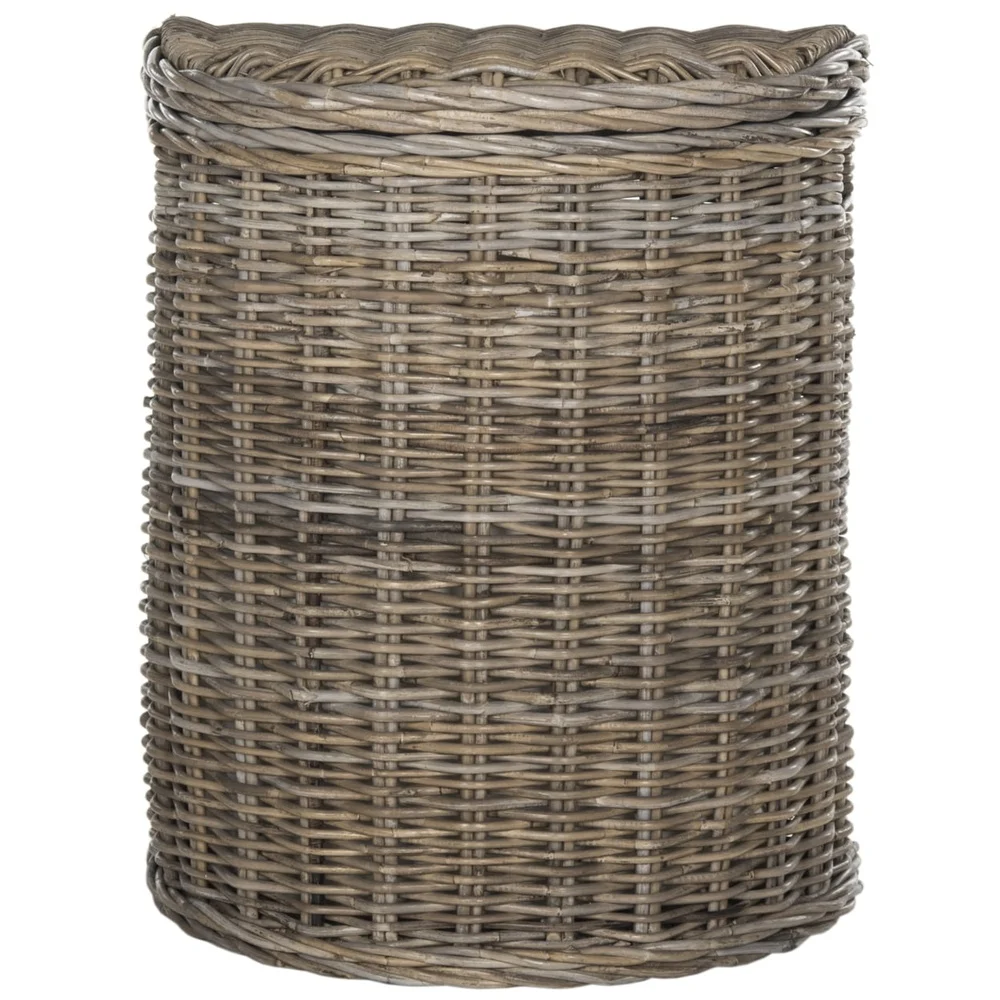
Advantages and Limitations of Wicker Baskets
Pros:
- Exceptional structural integrity and high load-bearing capacity
- Classic, timeless aesthetic that complements various decor styles
- Superior airflow preventing mustiness for stored items
- Available in diverse finishes from natural to painted colors
- Excellent longevity when properly cared for
Cons:
- Natural materials may warp or crack in high-humidity environments
- Some types can develop splinters or rough edges with age
- Intricate weaves can trap dust and make thorough cleaning challenging
- Heavier than many alternative basket types
- Generally higher price point compared to simpler woven options
Wicker baskets excel at providing both form and function. Their rigid construction means they maintain their shape even when fully loaded with heavy items like books, toys, or blankets. The classic appearance of wicker has remained in style for generations, making it a timeless investment rather than a passing trend.
The natural materials used in traditional wicker allow for excellent airflow, reducing the risk of mold or mildew on stored items. For items needing additional protection, wicker baskets with lids offer the perfect solution by combining ventilation with coverage.
However, natural wicker does require some care considerations. While extremely durable, it can be damaged by excessive moisture or direct sunlight over time. The synthetic vs. natural wicker decision often comes down to where you’ll be using your basket and under what conditions.
Exploring Non-Wicker Woven Baskets: Types and Techniques
Beyond traditional wicker, the world of woven baskets encompasses a rich variety of materials and techniques that offer different aesthetic and functional benefits.
Diverse Materials in Non-Wicker Woven Baskets
Seagrass and water hyacinth: These natural fibers create baskets with distinctive texture and a casual, organic appearance. They offer moderate durability with a lighter weight than traditional wicker.
Jute and sisal: Known for their strength and rustic appearance, these plant fibers create baskets with excellent tensile strength but less rigidity than wicker constructions.
Cotton rope and fabric: Soft, pliable materials that create flexible baskets perfect for linens, clothing, and lightweight items. These materials offer washability that rigid baskets can’t match.
Paper and recycled materials: Eco-friendly options that transform newspapers, magazines, or plastic into colorful, lightweight baskets ideal for decorative storage.
Wire and metal: Create baskets with an industrial aesthetic and exceptional durability. Metal woven baskets offer strength without the bulk of traditional wicker.
Different Weaving Techniques
Unlike wicker’s structured approach, other weaving techniques create different visual and structural characteristics. Coil weaving wraps material around a central core to create spiral patterns. Plaiting involves crossing strands over and under each other in various patterns. Twining uses active strands that twist around stationary ones to create the basket structure.
The manufacturing process for non-wicker woven baskets often allows for greater variety in shape, size, and design flexibility. Many of our woven storage baskets showcase these alternative techniques that offer unique benefits compared to traditional wicker construction.
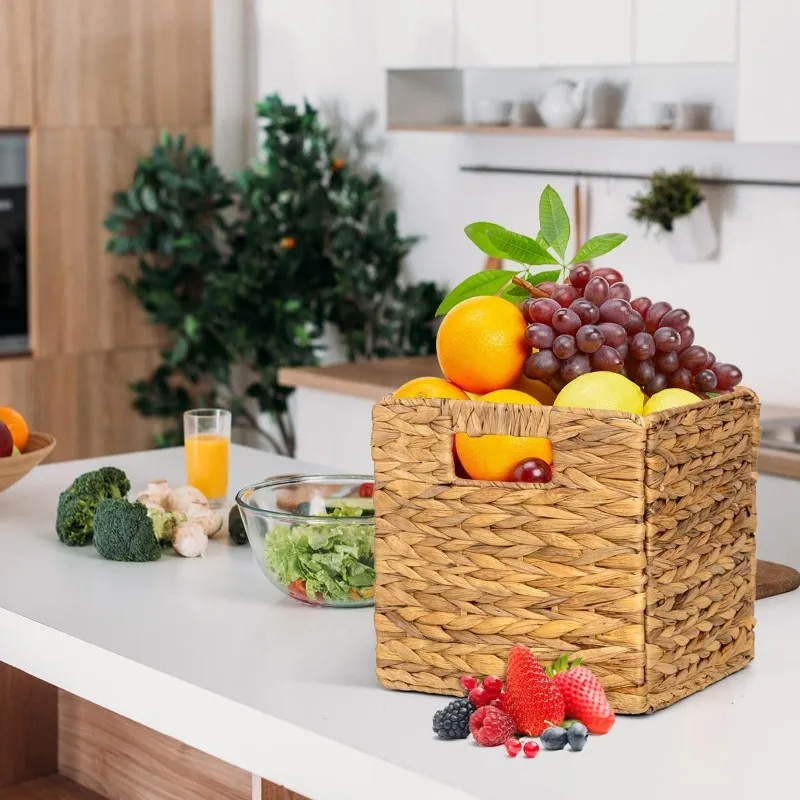
Benefits and Drawbacks of Non-Wicker Woven Baskets
Pros:
- Typically lighter weight making them easier to move and reposition
- Greater variety of textures, patterns, and contemporary designs
- Many options offer washability or easy cleaning
- More affordable entry points for budget-conscious shoppers
- Enhanced flexibility in shape and construction
Cons:
- Often lack the rigid structure needed for heavier items
- Durability varies significantly based on materials and construction
- Natural fiber versions may shed or fray over time
- May require more frequent replacement than sturdier wicker options
Non-wicker woven baskets shine in versatility and adaptability. Their lighter weight makes them ideal for situations where the basket needs to be frequently moved or carried. The diverse range of materials allows for creative expression through varied textures and colors that might not be possible with traditional wicker.
Many fabric and soft material baskets can be collapsed when not in use, making them perfect for seasonal storage or homes with limited space. Their flexibility allows them to conform to awkward spaces or unusual items that rigid baskets might not accommodate.
For those seeking natural materials with a different aesthetic than traditional wicker, rattan storage baskets provide an excellent middle ground. While rattan is often used in wicker construction, it can also be utilized in other weaving techniques for a more relaxed appearance.
Direct Comparison: Wicker vs. Other Woven Baskets
| Feature | Wicker Baskets | Other Woven Baskets |
|---|---|---|
| Construction | Rigid materials woven around a frame | Various techniques including coiling, plaiting, twining |
| Materials | Traditionally rattan, willow, reed; modern versions include synthetics | Vast range: seagrass, cotton, paper, metal, plastic, jute |
| Durability | High; can last decades with proper care | Varies widely; fabric types may last 1-5 years, others longer |
| Maintenance | Regular dusting; occasional gentle cleaning; keep from excessive moisture | Depends on material; many fabric versions machine washable |
| Cost | Generally higher; quality pieces start around $30-$100+ | Wide range; many options under $30 |
| Weight | Heavier, more substantial | Typically lighter, more portable |
| Structure | Maintains shape regardless of contents | May conform to contents or lose shape over time |
| Best Uses | Heavy items, long-term storage, display pieces | Light items, soft goods, seasonal storage, children’s rooms |
This comparison highlights the fundamental differences that make each basket type suitable for specific situations. When considering durability and structure against flexibility and weight, the choice becomes clearer based on your specific needs.
The benefits of both woven and wicker laundry baskets demonstrate how each type excels in different applications, with wicker providing structure and stability while other woven styles offer lightness and adaptability.
Which Basket Type is Best For Specific Needs?
Heavy Storage Needs
For books, toys, firewood, or other weighty items, traditional wicker baskets reign supreme. Their rigid construction and sturdy frame can support substantial weight without warping or collapsing. Look for thick rattan or synthetic wicker with reinforced handles if you’ll be moving heavy contents regularly.
Decorative Purposes
When visual appeal is your primary concern, both basket types offer unique benefits. Wicker provides a classic, structured look that works beautifully in traditional, farmhouse, or coastal decor. Non-wicker woven baskets, especially those made from colorful fabrics or unusual materials, make excellent accent pieces in contemporary or eclectic spaces.
Bathroom Organization
In humid environments, synthetic wicker or plastic woven baskets perform best. Natural materials may develop mold or mildew in consistently damp spaces. Look for options with open weaves to promote airflow and prevent moisture buildup.
Kitchen and Pantry
For food storage, consider hygienic materials that can be easily cleaned. Plastic woven baskets or lined wicker options work well. The structure of wicker makes it ideal for organizing heavier items like canned goods.
Laundry and Clothing
The differences between wicker and woven laundry baskets are particularly relevant here. Fabric woven baskets offer lightness and often collapsibility, while wicker provides stability and better airflow for damp items. Your specific laundry routine will determine which benefits matter most.
Outdoor Use
Only weather-resistant materials should be considered for outdoor storage. Synthetic wicker or specially treated natural materials can withstand exposure to the elements. Most standard woven baskets made from natural fibers will deteriorate quickly outdoors.
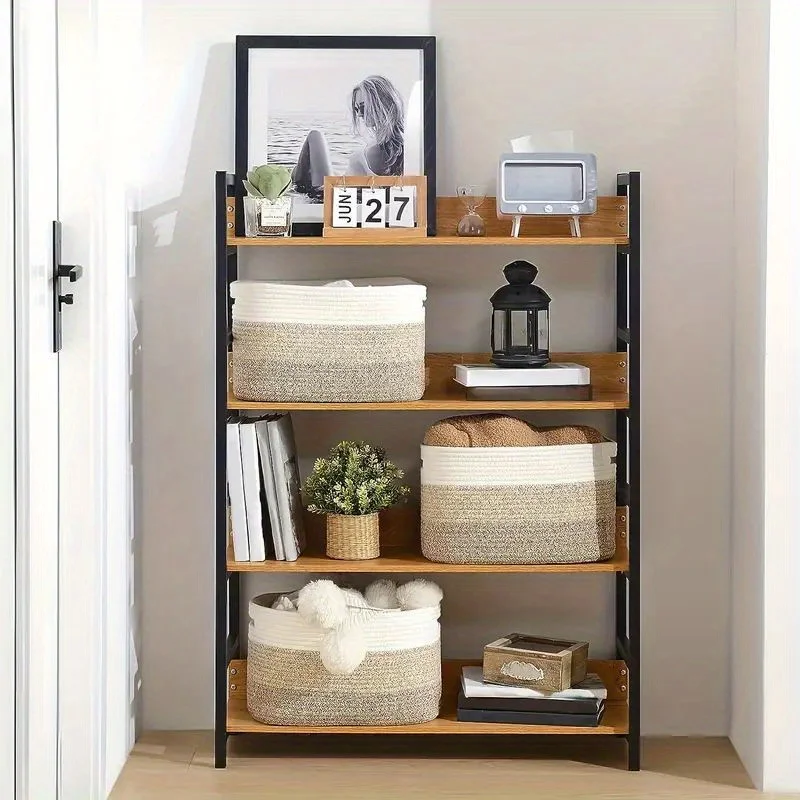
How to Choose Based on Your Home Décor Style
Modern and Minimalist Spaces
• Clean-lined metal wire baskets with geometric patterns
• Monochromatic fabric baskets with subtle texture
• Synthetic wicker in white, black, or gray tones
• Simple designs that focus on function without excessive embellishment
Farmhouse and Rustic Décor
• Traditional willow wicker with natural finishes
• Loose-weave water hyacinth with visible natural variations
• Rope baskets in natural tones like beige and cream
• Distressed finishes that suggest authentic vintage pieces
Coastal and Beachy Interiors
• Seagrass baskets with herringbone patterns
• Whitewashed or bleached wicker pieces
• Blue and white color combinations in fabric woven designs
• Rope baskets reminiscent of nautical elements
Bohemian and Eclectic Homes
• Colorfully dyed woven baskets with pattern variations
• Mixed material designs combining different weaving techniques
• Unusual shapes and asymmetrical elements
• Embellished pieces with tassels, beads, or decorative trim
Traditional and Classic Settings
• Dark stained wicker with tight, precise weaving patterns
• Structured shapes with defined edges and proportions
• Lined baskets with complementary fabric interiors
• Heritage-inspired designs with timeless appeal
Woven laundry baskets come in various styles to match your specific decor theme while providing essential functionality. The right basket not only serves its purpose but also enhances your overall design aesthetic.
Black Wicker Baskets, Rattan Storage Baskets, Tall Wicker Baskets, Wicker Shelf Baskets, Woven Storage Baskets
5-Tier Distressed Black Wood Frame Storage Tower with Removable Wicker Baskets for Home Organization$715.80 Select options This product has multiple variants. The options may be chosen on the product pageWicker Laundry Baskets, Woven Laundry Baskets, Woven Storage Baskets
$392.02 Select options This product has multiple variants. The options may be chosen on the product pageRattan Shelf Baskets, Rattan Storage Baskets, Small Wicker Baskets, Square Wicker Baskets
Square Plastic Wicker Storage Baskets Set of 3 with Collapsible Design for Cube Storage Organization$185.47 Select options This product has multiple variants. The options may be chosen on the product pageWicker Baskets with Handles, Wicker Storage Baskets, Woven Storage Baskets
$137.92 Select options This product has multiple variants. The options may be chosen on the product pageLarge Wicker Laundry Baskets, Tall Wicker Baskets, Woven Laundry Hampers, Woven Storage Baskets
$130.54 Select options This product has multiple variants. The options may be chosen on the product pageWoven Laundry Baskets, Woven Laundry Washing Baskets
Price range: $136.76 through $581.37 Select options This product has multiple variants. The options may be chosen on the product page
Essential Care and Maintenance Tips
Natural Wicker Maintenance
• Dust regularly with a soft brush or vacuum with brush attachment
• Clean spills immediately with a barely damp cloth
• Apply furniture polish or lemon oil occasionally to maintain flexibility
• Keep away from direct sunlight and heat sources to prevent drying and cracking
• Maintain optimal humidity levels to prevent brittleness
Synthetic/Resin Wicker Cleaning
• Rinse with a garden hose or wipe with damp cloth
• Use mild soap solution for stubborn dirt
• Soft brush can reach between weaves for thorough cleaning
• Dry completely before storing or using for storage
• UV-resistant sprays can extend lifespan of outdoor pieces
Fabric and Rope Basket Care
• Follow washing instructions if machine washable
• Air dry completely to prevent mold growth
• Reshape while damp to maintain proper form
• Spot clean non-washable versions with appropriate cleaners
• Store flat or stuffed with paper when not in use to maintain shape
Seagrass and Natural Fiber Preservation
• Avoid water exposure whenever possible
• Clean with dry brush or vacuum only
• Remove mold with diluted vinegar solution applied sparingly
• Place in sunlight occasionally to naturally disinfect
• Use protective spray designed for natural fibers
For specific spaces like laundry rooms, proper wicker basket maintenance ensures both longevity and continued aesthetic appeal. With proper care, quality baskets from Tidy Treasure can last for many years, making them a worthwhile investment for your home.
Making Your Final Decision: Key Factors to Consider
When choosing between wicker and other woven baskets, consider these crucial factors to guide your decision:
Primary Function Requirements
• Weight of items to be stored
• Frequency of access needed
• Visibility of contents desired
• Portability requirements
• Need for structural integrity
Budget Considerations
• Initial investment vs. longevity value
• Replacement frequency expectations
• Quality level appropriate for usage
• Price-to-durability ratio
Space and Physical Constraints
• Available floor or shelf space
• Weight limitations of storage area
• Need for stackability or nesting
• Transportation and movement requirements
Environmental Factors
• Exposure to moisture or humidity
• Sunlight exposure in intended location
• Temperature fluctuations in storage area
• Potential for pest issues
Aesthetic Preferences
• Compatibility with existing decor
• Desired texture and visual impact
• Color scheme integration
• Statement piece vs. subtle storage
Understanding the differences between laundry hampers and baskets illustrates how function should guide your selection process. The perfect basket balances practical considerations with aesthetic preferences to create storage that truly works for your lifestyle.
Frequently Asked Questions About Wicker and Woven Baskets
Can wicker baskets be used outdoors?
Natural wicker is not recommended for continuous outdoor use as it can warp, crack, and grow mold when exposed to the elements. However, synthetic or resin wicker is specifically designed for outdoor conditions and can withstand sun, rain, and temperature fluctuations with minimal maintenance.
Are woven baskets eco-friendly?
Many woven baskets, especially those made from natural materials like seagrass, rattan, or water hyacinth, are highly sustainable. These renewable resources grow quickly and require minimal processing. Look for baskets made without harsh chemicals or dyes for the most environmentally friendly options.
How do I remove mold from natural fiber baskets?
For light mold, take the basket outdoors and brush away visible spores with a soft brush. Then wipe with a cloth dampened with equal parts white vinegar and water. Allow to dry completely in sunlight, which naturally inhibits mold growth. Severe mold may permanently damage natural fibers.
Which basket type is most durable for daily use?
For high-traffic areas and everyday use, synthetic wicker offers the best combination of durability and low maintenance. Natural wicker follows close behind but requires more care. Fabric and soft woven baskets are better suited for lighter use or decorative purposes.
Can I wash my woven fabric basket?
Many fabric baskets are machine washable, but always check the care instructions first. Use cold water on a gentle cycle and air dry to maintain shape and prevent shrinkage. Baskets with cardboard or wooden reinforcements typically cannot be fully immersed in water.
For more detailed information about different construction methods, our guide to the 4 main types of basket weaving provides valuable insights that can help inform your purchasing decisions.
At Tidy Treasure, we believe in the philosophy of “Organizing Life Beautifully, One Basket at a Time,” and understanding the fundamental differences between basket types is the first step toward finding your perfect storage solution.

